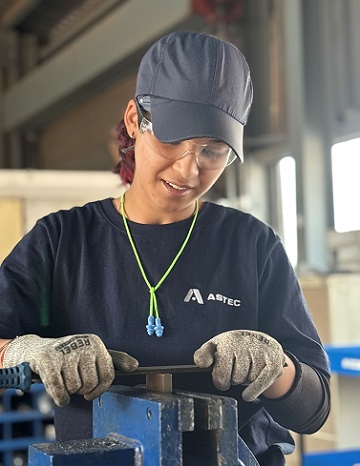In celebration of Women’s Month in South Africa, global equipment manufacturer Astec Industries has put the spotlight on three remarkable women who are making their mark in a traditionally male dominated industry.

All three are making a significant contribution to the success of Astec’s operations as they help to build the proudly South African heavy equipment that goes from Astec’s Johannesburg manufacturing facility to mines, quarries, construction and infrastructure sites around the world. And while building heavy-duty machines, they are serving as role models, striving to ensure a future in which ability, not gender, is all that matters in engineering and all other fields.
Transforming metal and perceptions
Kate Mampa, a turner machinist at Astec since 2019, reveals that her journey into engineering was born from an interest in hands-on, detailed work and a fascination with seeing raw materials transformed into critical components for massive industrial equipment, as well as with the intricacy and interdependence of machine components. “Every part that I machine has a purpose,” she says. “Knowing that it fits into a bigger system gives me real pride.”
But the road wasn’t always smooth. Early in her career, Kate encountered doubt that she could not handle tight tolerances or complex jobs. She met these challenges head-on. “I stayed focused, asked questions, learnt from mistakes and let my work speak for itself.” Today, Kate is undaunted by the challenges of tough material, high precision components with very tight tolerances and tight deadlines, and she’s committed to being a role model and mentor for other women. “By doing my job with skill, confidence and professionalism, I hope to inspire other women to pursue careers in this industry and make it clear that gender does not define ability.”
“Bubbles” of strength and ability
For diminutive Azariah Heradien, who is affectionately known as “Bubbles” at Astec, the journey into engineering started as a child at her father’s side, watching and learning as he worked in the electrical field. Now a third-year millwright apprentice at Astec, she says that her start in the industry did have some challenges. “I was underestimated,” she recalls. “My age, size and gender influenced how my male colleagues perceived my capabilities.” But she refused to be boxed in by those assumptions. “I had to earn their respect, not just as a person but as a fellow employee.”
Her biggest personal breakthrough came not from mastering machinery, but from finding her voice. “Having the technical skills and knowledge is vital, but it is equally important to engage in meetings and take on the responsibility of certain jobs.” She found confidence and learnt to “speak up and step up”. Azariah’s message to young women aspiring to follow her path is: “Never let your age, gender, build or others’ opinions limit you. Who you are paves a way, but who you want to become can be your destination.
“I hope that my presence will help inspire and motivate aspiring female engineers.”
From apprentice to leader
Astec’s Beauty Ramokhali is not your typical boilermaker. Nor is her career journey, which started with a boilermaking apprenticeship, an experience that she says opened the door to the fascinating world of large-scale manufacturing. “I was fascinated by the scale, complexity and impact of heavy equipment manufacturing. I knew I wanted to be part of an industry that builds powerful, purposeful machines that shape the world around us.”
Beauty has risen from artisan boilermaker to operations intern, then operations engineer at Astec Industries. She was recently promoted to her current role of operational excellence manager and she leads strategic initiatives to improve operational performance. Her leadership is driven by a simple but powerful philosophy: “Knowing that the decisions I make each day are building blocks for a better tomorrow - both for the business and for the people behind it.”
Beauty says that she’s had to prove herself. “Being a woman in a male-dominated environment, I have certainly been underestimated at times. But I let my work speak for itself. I thrive under pressure and take pride in consistently exceeding expectations.” Her biggest challenge? Driving change in a space where old habits die hard. Her approach encompasses empathy, clarity and inclusion, and this is how she is shifting mindsets and building trust.
Beauty sees her career journey as a symbol of possibility. “My growth and success in this field serve as proof that it can be done. Women not only belong in engineering and heavy equipment manufacturing, but they can also thrive and lead.”
Positive changes
Kate, Azariah and Beauty all agree that there have been positive changes in the industry on the gender diversity and equality front since they started their careers. “Training programmes, mentorship and workplace policies have improved to support women’s advancement.”
Kate says that she is optimistic because the conversation about inclusion is stronger than ever.
For young girls wondering whether they belong in overalls and steel-toed boots, these Astec role models offer a resounding message: You do - if that’s where you want to be. “With confidence, resilience and a strong belief in your own ability, you will thrive,” Beauty asserts.
Azariah echoes this. “Gender is just that and not a limitation,” she stresses.
Succeeding, developing and advancing is about skill, mindset and determination, all three women believe, and say that at Astec, they are given room to grow and not treated differently to male counterparts.



